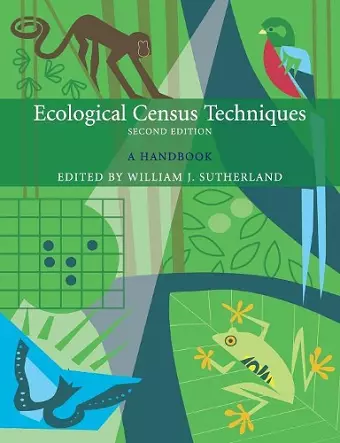Ecological Census Techniques
A Handbook
Format:Paperback
Publisher:Cambridge University Press
Published:3rd Aug '06
Currently unavailable, and unfortunately no date known when it will be back

The practical methods necessary for carrying out an ecological census of plants and each group of animals are described here.
Most work in ecology or conservation requires a census of the population. Experts describe the practical methods necessary for carrying out a census. The book includes the underlying theory and the practical details for plants and each group of animals, alongside the environmental measures that can be done simultaneously.This is an updated version of the best selling first edition, Ecological Census Techniques, with updating, some new chapters and authors. Almost all ecological and conservation work involves carrying out a census or survey. This practically focussed book describes how to plan a census, the practical details and shows with worked examples how to analyse the results. The first three chapters describe planning, sampling and the basic theory necessary for carrying out a census. In the subsequent chapters international experts describe the appropriate methods for counting plants, insects, fish, amphibians, reptiles, mammals and birds. As many censuses also relate the results to environmental variability, there is a chapter explaining the main methods. Finally, there is a list of the most common mistakes encountered when carrying out a census.
Praise for the first edition: 'There are too few books like this that help students to see the broad picture of census methods and yet warn them of the censusing sins listed in the last chapter of the book … This book will assist university lecturers in teaching the methods essential to developing reliable databases for conservation and management, and for testing ecological theory.' Charles J. Krebs, Trends in Ecology and Evolution
'… easy to read and with a full discussion of biases as well as usages there's every potential for this text to be an essential reader for ecology students (and staff!).' British Ecological Society, TEG News
'…an excellent guide … The book will be useful to ecologists at all levels.' Aslib Book Guide
'Well illustrated with line drawings, tables, graphs etcetera this book provides a comprehensive overview of the most important methods for those working on field studies in population and behavioural ecology - amateur and professional alike.' Bryan Sage, Countryside
'Anyone planning a census programme as part of a conservation monitoring project should consult this book.' Peter D. Moore, New Scientist
'… a must for every student of ecology and should be used by every individual interested in counting organisms in the field. Researchers in population and behavioural ecology and those interested in conservation of species would find this book very useful.' J. P. S. Chauhan, International Journal of Ecology and Environmental Sciences
'A comprehensive handbook … an excellent book for beginners and professionals alike.' M. Bonsall, Biologist
' … a very thorough and useful guide to everything you need to know about planning and carrying out an ecological study. The first three chapters provide a sound basic grounding in designing a study, and assist in defining the best sampling and census methodology techniques that can be applied in a wide range of situations. The book is clearly written and set out so that it is simple enough for students to understand while including enough detail to still be useful for experienced researchers.' Ecological Society of Australia
ISBN: 9780521606363
Dimensions: 246mm x 190mm x 22mm
Weight: 880g
446 pages
2nd Revised edition